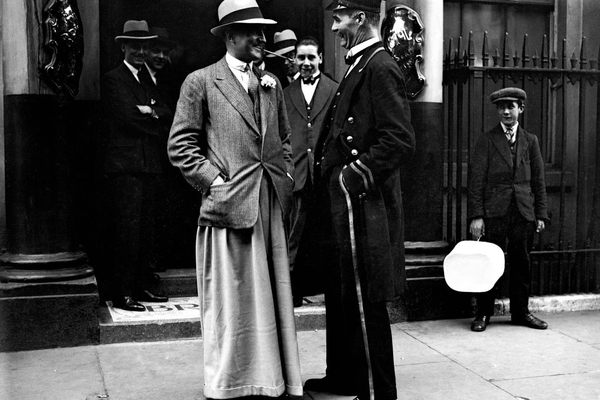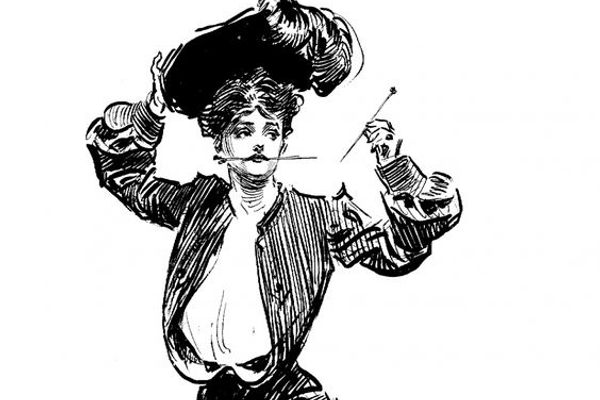The Long and Bumpy History of Corduroy
It may be most closely associated with the ’70s, but the ribbed fabric’s pedigree goes back many centuries.

A version of this post originally appeared on Tedium, a twice-weekly newsletter that hunts for the end of the long tail.
There’s a new all-corduroy fashion line out there called The Cords & Co, which is in the midst of rolling out seven dedicated corduroy stores globally.
Speaking to The Evening Standard, founder Michael Söderlindh emphasized that he built an all-corduroy brand because the public is ready.
“There are lots of brands that have done their take on corduroy but there has never been a brand that has completely dedicated themselves to it,” Söderlindh said. “I am convinced that people are looking for a lasting alternative to denim. We want people all over the world to rediscover their love for corduroy.”
It sounds like an absurd, perhaps even improbable idea for a clothing line, yet here we are in 2017, at the cusp of embracing once-unfashionable cords all over again.
According to Refinery29, in fact, “the corduroy comeback is in full swing.”

Though its popularity has waxed and waned over the decades, the fabric certainly has its staunch devotees. Take Miles Rohan, the the founder of the Corduroy Appreciation Club. Here’s how, back in 2006, explained to Maximum Fun in 2006 why he’s such an unabashed corduroy fan: “If I’m not wearing at least one piece of corduroy, I don’t feel right. The repetition, the parallel lines, the thickness I’ve always thought, provided a kind of order and support. And because I’m not entirely the most orderly person, it helps. But even when I was little I loved corduroy. It made me feel grown up and sophisticated. I’m more of a pin wale person, but at times I love a nice wide wale.”
(Note his use of the term “wale,” the common terminology for the number of ridges per inch that a piece of corduroy has.)
Now, corduroy didn’t naturally start out in its gracefully tufted form.
Corduroy’s roots are in the ancient Egyptian city of Al-Fustat. Located near the Nile river, the city became something of a ground zero of tough woven fabrics around the second century.
It also, at least for a while, played a significant historic role—in 641, it became the first Arab settlement in Egypt and served as the country’s capital for two separate periods totaling more than 300 years. But in the midst of the Crusades, the city’s top political official ordered the city burned in a desperate attempt to prevent its wealth from being stolen.
Since that time, Al-Fustat has lost its high level of influence in the region, as nearby Cairo, which was only founded in 969 AD, usurped it in the 12th century to become Egypt’s capital.

As it turned out, this lost city’s biggest legacy in the Western world was the predecessor fabric to corduroy, which became known as fustian, a clear riff on the Egyptian city’s name. It’s a heavy cloth that works well for things like pants, but unlike corduroy, it doesn’t feature any raised cords.
The 1870s textbook Textile Fabrics highlighted this lineage.
“Fustian, of which we still have two forms in velveteen and corduroy, was originally wove at Fustat on the Nile, with a warp of linen thread and a woof of thick cotton, so twilled and cut that it showed on one side a thick but low pile; and the web thus managed took its name of Fustian from that Egyptian city,” the Very Rev. Daniel Rock D.D. wrote.
The fabric at one point was closely associated with the Catholic Church, after a Cistercian abbot forced chasubles—the outer vestments worn by priests—to be made out of basic linen or fustian, rather than more expensive materials. The fabric had a tendency to be both associated with high-minded pompousness (see the fact that Shakespeare turned fustian into an adjective of that nature) and working-class living. And this was before corduroy even got any cords.

In the book The Condition of the Working-Class in England in 1844, German philosopher Friedrich Engels noted how common fustian fabric was among the people he was writing about.
“The men wear chiefly trousers of fustian or other heavy cotton goods, and jackets or coats of the same,” Engels recalled. “Fustian has become the proverbial costume of the working-men, who are called ‘fustian jackets,’ and call themselves so in contrast to the gentlemen who wear broadcloth, which latter words are used as characteristic for the middle class.”
The book doesn’t mention of corduroy, alas, but its modern-day form came from a similar working-class roots—and is widely believed to have gotten its corded magic in Manchester, England. At least that’s the claim the corduroy hawkers at Brooks Brothers make.
An 1891 edition of the Transactions of the Philological Society, a London-based group, puts the creation of corduroy at between 1776 and 1787, though there is a 1774 mention of imported corduroys from Britain in the Newspapers.com archive.
In her 1973 Chicago Tribune article on corduroy, Marylin Stitz mentioned that the name of the material is French in origin, standing for an anglicized “Cord du Roi.” The Philological Society, however, did not share that view.
The philological group, which studies the development of languages, stated that the French variation of the word was in fact referred to as “the king’s cord,” but in an already Anglicized way—kings-cordes, to be specific. Meanwhile, other elements of the English language didn’t make it to France.

“The word duroy as the name of a coarse woollen fabric, manufactured with verges and druggets in the West of England in [Robinson Crusoe author Daniel] Defoe’s time, has evidently no connexion,” the society explained.
The society additionally discussed the possibility that the fabric was named after someone named Corderoy, only for that linguistic meaning to get morphed slightly.
We’ll likely never know for sure because history is hazy on this point, but a 1772 mention of “corderoys,” in reference to the fabric being imported, supports the claim, for what it’s worth.
It’s either that, possibly, or that someone saw the cords on these pants and thought it fit perfect with “duroy.”
Corduroy may be the ultimate always-going-in-and-out-of-fashion fabric.
To prove the point, we’re going to play a game here. Below are quotes from three trend pieces about how corduroy is coming back into style. Guess the year for each:
- “It’s amazing. People are coming in like crazy and asking for corduroy slacks and sport coats—even with patches on the sleeves.”
- “Its royal roots may be in question, but there’s no debating that corduroy has made a grand comeback.”
- ”One of the ‘new faces’ on the fashion scene this season is corduroy. Although this cotton is a traditional classic, new treatments give it a lease on life.”
If you guessed 1994, 2002, and 1952, you are correct.

Of course, corduroy wasn’t always in comeback mode. If you were, however, to set a single decade as “peak corduroy,” which decade might you choose?
If you said the 1970s, ding ding ding we have an answer! In 1973, the Chicago Tribune’s Marylin Stitz really nailed the interest in corduroy at the time:
When you think about transitional dresses, playtime outfits, and back to school togs, one fabric comes to mind. Corduroy.
Why? Because it’s luxurious and functional at the same time. It can look dressed up or dressed down. It holds its shape and is easy to care for. It adapts well to clothing for your entire family. It’s durable—and economical.
As for the 21st-century resurgence, it appears modest so far. Rohan of the Corduroy Appreciation Society started an all-corduroy online store in 2016, which sells tufted ties and jackets. All outfits are designed by Rohan, with cloth coming from the birthplace of modern corduroy, Northern England.
As neat as corduroy is, it doesn’t generate a ton of die-hards. Folks who are really into the fabric, like Rohan, are few and far between. Corduroy is the fashion industry’s variation on the McRib—an inoffensive-enough product that retailers can go back to when they need a short-term hit, something that has just enough novelty to it that people will buy it because they’ve read somewhere that corduroy is making a comeback.
For the rest of us, we don’t really think in terms of wales all that often.
A version of this post originally appeared on Tedium, a twice-weekly newsletter that hunts for the end of the long tail.









Follow us on Twitter to get the latest on the world's hidden wonders.
Like us on Facebook to get the latest on the world's hidden wonders.
Follow us on Twitter Like us on Facebook